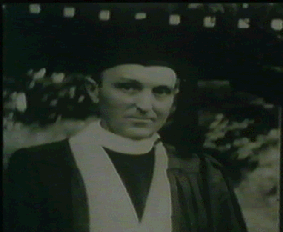

Reverend John Magee was an Episcopal pastor. He was one of the 22 Westerners in charge of the so-called Nanjing International Safety Zone created when the Japanese army captured Nanjing in 1937. He tried to protect as many Chinese as possible during the Japanese occupation and saved thousands from being raped, bayonetted, and shot by the Japanese soldiers. He filmed many of these victims on 16mm black and white silent film. He also recorded how the victims were injured in a diary that became a valuable historical document recording the Massacre.
At that time, the German diplomat Mr. John Rosen sent a copy of Magee's film to the Nazi government since he was angry about the Japanese atrocities. He also included a long report which claimed that the whole Japanese army was a violent killing machine. In it, he requested that the film be shown to Hitler.
Chinese and Japanese scholars were aware of the film but were unable to locate it. Japanese right-wing extremists then said that since there was no proof, the Nanjing Massacre never occurred. When the German Archive at Botsdam was opened in 1990, the Rosen report surfaced, but the film's whereabouts were unknown.
A gronddaughter of Mr. Fitch, Ms Edith Fitch, has a film about Fitch's work in China which included scenes of the Nanjing Massacre. This film had been given to the Los Angeles Film Museum. In December 1990, she saw an advertisement placed by the Chinese Alliance for Memory and Justice in the New York Times so she sent a copy of the film to the Alliance in Memory of Victims of the Nanjing Massacre for reference. From this clue, the search for Reverend Magee's film started. Some Japanese reporters were very interested in finding the film as well.
Four rolls of the 16mm film were finally found in the house of Mr. David Magee, Reverend Magee's son. The film was generally in good condition and it contains more scenes than the two films mentioned above. According to Reverend Magee's diary, he was too busy helping the victims to do more filming. He could only record a very small part of what he saw.
When George Fitch returned to the US, he showed the film to many groups, trying to inform the American people about what had happened. At the time, a big issue was the practice of selling US scrap metal to Japan; Fitch and others were trying to convince the government, among other things, that US scrap metal was being turned into weapons that were being used against the Chinese and other friends. They thought that showing this film would stop that practice.
Unfortunately, Mr. Fitch's health was not good, and he was unable to keep up his schedule of screening the film. He gave a copy to my grandfather, Arthur N. Bierkle, whom he had met at one of the film viewings. My grandfather was already active in the effort to stop support to Japan, and was further interested because he had lived in China from 1925-1933, including a year as a language student at the University of Nanjing. He picked up where Mr. Fitch had had to leave off, screening the film for many civic groups, mainly in the southern California area.
For years the film lay forgotten in my mother's basement. Last year we donated it to the Library of Congress film department, which was able to salvage and restore about 13 minutes of the old, brittle film, and add it to their permanent collection. It was our family's recollection that the Kodak lab in Shanghai had made 4 copies, of which this was one. One other was supposedly given to a woman who took it to Japan at the time, convinced that if the Japanese saw it, they would be appalled and stop what they were doing. Needless to say, we heard that that copy disappeared, never to be seen again. Thank you for the well done website, it is appreciated.
NOTE: Thank you for your infromation. We will not forget your help.--the Hall Maintainer